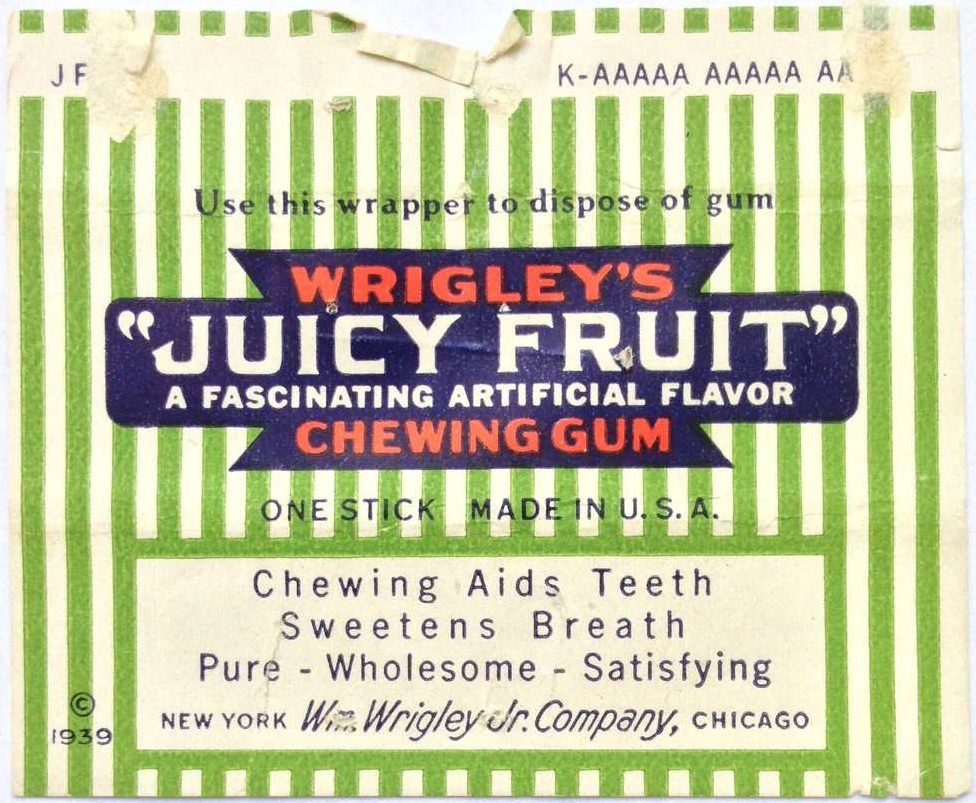
 Sugar was cheap during the Great Depression. Chewing gum was an affordable treat that sold well. But New York City was paying a high price to scrape the sticky mess from the ground.
Sugar was cheap during the Great Depression. Chewing gum was an affordable treat that sold well. But New York City was paying a high price to scrape the sticky mess from the ground.
The city had recently taken over the Independent Subway Line and balked at the cost of cleaning gum from the platforms. The Mayor released a statement to the morning papers on December 4, 1939: “This may seem like a trifling matter, but it costs the City of New York literally hundreds of thousands of dollars a year to remove gum from parks, streets and public places.”
The Secretary of the Board of Transportation, William Jerome Daly, informed the Mayor that two workers scraping the worst stations for six months “were eventually transferred to other duty because their efforts were futile. It was just a hopeless task.” He agreed with the Mayor that the only remedy was the correction of bad manners.”
The size of that group of gum droppers would be unscientifically tallied by William Powell, the Assistant Commissioner of the Department of Sanitation. He guessed that one in five people who lived in New York City chewed gum. Since there were approximately seven million people living in New York City in 1939, that added up to about 1.3 million gum chewers.

 What kind of leader attempts to change the bad manners of 1.3 million New Yorkers? Mayor Fiorello LaGuardia
What kind of leader attempts to change the bad manners of 1.3 million New Yorkers? Mayor Fiorello LaGuardia
LaGuardia served as Mayor for three terms through the 1930s and 1940s. Barely five feet tall, the “Little Flower” backed progressive causes and helped New Yorkers survive the Great Depression and Second World War. He was known as a tireless advocate for children. He brought entire orphanages to baseball games. He read the funny papers live on the radio for children during a newspaper strike.
LaGuardia’s idea was to attack the sticky problem with a cultural campaign. No fines, no bans, no summonses, but a contest to win over the hearts and minds of everyone who cared about New York City. He issued a press release that resulted in numerous stories in newspapers across the country.
The Mayor’s campaign invited the public to teach and encourage themselves to act appropriately. And the public responded with creativity! Among the suggestions were “Shoot the Wad” and “Don’t be dumb, park your gum!”
Milton W. Firth, wrote the Mayor. “The carelessness with of gum chewers in littering the city pavements and subway platforms has long been a source of annoyance to me, and I am greatly pleased to see that someone has started a campaign to rid the city of this nuisance,” he offered. “After all it is but one step behind expectorating [spitting], and that is a misdemeanor.”
Firth suggested a new law “prohibiting the careless practice of discarding chewing gum in public places.” His suggestion for the new campaign? “Try to keep your city dapper. Park used gum inside this wrapper [sic].”
Edith Goldberg of Brooklyn suggested “Wrap your gum. You, too, have a sole.” Four pages of cartoons with captions came from Frances Paelian of Spuyten Duyvil in The Bronx. From East Hapswell, Maine came “Chew It. But Don’t Strew It.”

 John F. Klohr, purveyor of “Insurance of All Kinds,” confessed to giving away sixty sticks of gum per day for 15 years. He expressed remorse, and promised that in the future he would encourage people to use the wrapper in disposing of the gum.
John F. Klohr, purveyor of “Insurance of All Kinds,” confessed to giving away sixty sticks of gum per day for 15 years. He expressed remorse, and promised that in the future he would encourage people to use the wrapper in disposing of the gum.
John Krol, a former employee of the Parks Department, sent “Chew! But Don’t Strew Your Streets With Goo!” A poem in the style of Robert Burns was submitted by Redmond O’Hanlon entitled “Owed to N.Y.C. – Gum Free Streets.”
The winning slogan was submitted by Miss Rose L. Beckman, a teacher at the Abraham Lincoln High School in Brooklyn: “Don’t Gum Up the Works.” The winning entry beat out “Chucking Chicle Chokes the Charm of our Choo-Choo Station.”
The candy and gum manufacturers responded with enthusiastic support. They printed new directions on packaging: “Park used gum inside this wrapper.” And they made tin signs to encourage good manners.
A letter from Philip K. Wrigley of the William Wrigley Jr. Company (Chicago) supported the Mayor’s quest, offering to change the next print run of advertising cards for street cars, buses and train cars. However, Wrigley mentioned that the American Chicle Company, a chewing gum trust, had vending rights on the City-owned Eighth Avenue Subway, and as such, there wasn’t much more the Wrigley Company could do on this line, without additional vending right.
The Vice President of the American Chicle Company wrote back to the Mayor from his New Jersey office: “we are pleased to advise you that on or shortly after the first of next year the 1c wrappers of all of our standard brands will bear the legend ‘Save this Wrapper for Disposal of Gum after Use.’” American Chicle also maintained their vending rights on the Eighth Avenue Line.

 The Goudey Gum Company, of Boston, and Beech Nut, of Amsterdam, NY, both supported the campaign. Sweets Laboratories, in Harlem, supported the Mayor’s plight, but explained that they sold chicle – the gum base – to gum manufacturers.
The Goudey Gum Company, of Boston, and Beech Nut, of Amsterdam, NY, both supported the campaign. Sweets Laboratories, in Harlem, supported the Mayor’s plight, but explained that they sold chicle – the gum base – to gum manufacturers.
The campaign spread to the airwaves. Chiclets publicist David O. Alber notified the Mayor about the Frank Novak and the Stardusters radio show, sponsored by Chiclets on NBC, to be aired in mid-December, 1939. The Stardusters, a male trio, would sing a song (featuring Chiclets) about good gum manners to the tune of “Comin’ thru the Rye.”
Chiclets also promised to “go even further in this campaign by inserting notices in each package of gum, urging purchasers to save the wrappers for use in disposing of the gum.”
Young & Rubicam, the marketing firm, produced a newsreel about the gum-wrapping campaign for The Fred Allen Show.
On January 25, 1940, the Assistant Commissioner of Sanitation, Edward Nugent, reported on the impact of the campaign: “from observations in touring the city, the Mayor’s effort has brought a decided improvement in this matter.”
The campaign ended swiftly and peacefully. Unfortunately, the battle against gum continues.
This essay by Mary Beth Kilkelly was first published on the New York City Municipal Archives Blog. The Municipal Archives preserves and makes available New York City government’s historical records. Records include office documents, manuscripts, still and moving images, vital records, maps, blueprints, and sound recordings. Learn more about historical records the Municipal Archives at their website.
Illustrations, from above, from the Mayor LaGuardia Collection, New York City Municipal Archives: A subway car of the Independent Subway Line with a public service announcement from Doublemint Gum, ca. 1940s; Fiorello La Guardia, ca. 1940s; a newspaper article on the gum campaign, December 4, 1939; and a Wrigley’s ‘Juicy Fruit’ chewing gum wrapper with the public service announcement “Use this wrapper to dispose of gum.”






